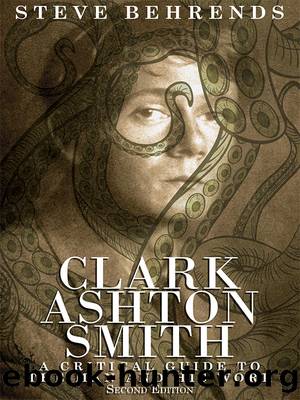Clark Ashton Smith by Steve Behrends

Author:Steve Behrends
Language: eng
Format: epub
Tags: fantasy writers, horror writers, author study, H.P. Lovecraft, lovecraft circle
ISBN: 9781434446718
Publisher: Wildside Press LLC
Published: 2013-04-08T00:00:00+00:00
113. âWhere Fantasy Meets Science Fictionâ (PD).
114. Letter to Barlow, 16 November 1933.
115. Letter to Lovecraft (#36, LL), ca. early November 1933.
116. âRealism and Fantasyâ (PD).
117. Letter to Lovecraft (#14, LL), ca. 21 October 1930.
118. Letter to Derleth, 3 November 1931.
119. âWhere Fantasy Meets Science Fictionâ (PD).
120. Fantasy and Human Experienceâ (PD). This belief echoes Lovecraftâs dictum that âthe true hero of a marvel tale is not any human being, but simply a set of phenomenaâ (âSome Notes on Interplanetary Fictionâ). It is interesting to note that while Lovecraft considered his statement as advancing the cause of realism in literature, Smithâs own statement was a reaction against the realist school. In fact, both men were fundamentally in agreeÂment with one another. Both considered the generation of atmosÂphere the most important job for a writer of imaginative fiction. For Lovecraft, the height of a weird story came when a single unnatural event was revealed against a meticulously constructed realistic background of people and places. He was interested in an atmosÂphere of abnormality, created through contrasts of the prosaic and the impossible; ârealismâ was crucial in developing the sense of normalcy against which the impossible is portrayed. On the other hand, Smithâs own interests centered on descriptions of the wondrous or unnatural events themselves, on the creation of an atmosphere of awe and mystery. Fritz Leiber has noted this: â[Smith] seldom put realistic details into his stories simply for the sake of making the fantastic events more plausible, though describÂing such fantastic events with the greatest possible realismâ (âClark Ashton Smith: An Appreciationâ, IM).
Smith and Lovecraft disagreed only on the question of emÂphasis, on the balance of the mundane and the fantastic in their stories, and both employed detailed, ârealisticâ descriptions to create atmosphere and mood. But, because the moods they wished to generate were different, Lovecraft chose to emphasize and describe the mundane or realistic aspects of his stories, whereas Smith concentrated on the fantastic.
Download
This site does not store any files on its server. We only index and link to content provided by other sites. Please contact the content providers to delete copyright contents if any and email us, we'll remove relevant links or contents immediately.
4 3 2 1: A Novel by Paul Auster(12333)
The handmaid's tale by Margaret Atwood(7711)
Giovanni's Room by James Baldwin(7256)
Asking the Right Questions: A Guide to Critical Thinking by M. Neil Browne & Stuart M. Keeley(5712)
Big Magic: Creative Living Beyond Fear by Elizabeth Gilbert(5681)
Ego Is the Enemy by Ryan Holiday(5350)
The Body: A Guide for Occupants by Bill Bryson(5033)
On Writing A Memoir of the Craft by Stephen King(4893)
Ken Follett - World without end by Ken Follett(4686)
Adulting by Kelly Williams Brown(4536)
Bluets by Maggie Nelson(4515)
Eat That Frog! by Brian Tracy(4484)
Guilty Pleasures by Laurell K Hamilton(4395)
The Poetry of Pablo Neruda by Pablo Neruda(4066)
Alive: The Story of the Andes Survivors by Piers Paul Read(3998)
White Noise - A Novel by Don DeLillo(3982)
Fingerprints of the Gods by Graham Hancock(3966)
The Book of Joy by Dalai Lama(3947)
The Bookshop by Penelope Fitzgerald(3812)
